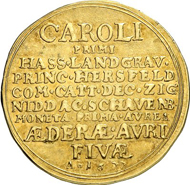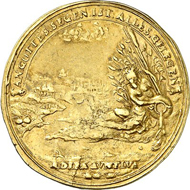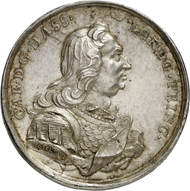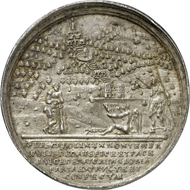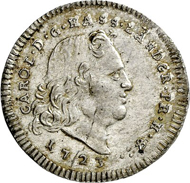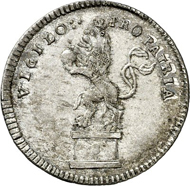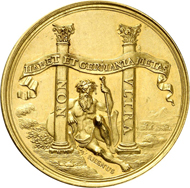Born on August 3, 1654, Charles, Landgrave of Hesse, was a child of the baroque period. At the time of his birth, six years had passed since the peace treaties of Osnabrück and Münster, but the wounds of the Thirty Years’ War had still not healed.
Charles I, Landgrave of Hesse-Kassel. Copper engraving around 1700. Source: Vrije Universiteit, Amsterdam / Wikipedia.
Charles was only 21 years old when he officially took control of the government, and it was a difficult burden. The duties and challenges were so vast as to seem almost insurmountable: There had been dramatic population losses from the war that needed to be offset and the economy needed to be entirely revived. On top of that, the emperor was demanding ever more troops to deploy to the French Front in the so-called Dutch War (better known as the ((second)) predatory war of Ludwig XIV).
2 gold gulden 1677, Kassel, Eder-gold. Rv. Riverscape on the Eder, in the foreground, the river god is n. l. storing oars and an urn in the reeds. Friedberg 1271 (‘Unique’). From Künker auction 220 (October 30, 2012), 7589. Estimate 100,000 EUR.
Despite these seemingly impossible challenges, Charles was well prepared. He had been well taught in the ways and principles of the prevailing economic system of the time, mercantilism, and had become more than adept at applying these principles successfully. He knew to promote a country’s own resources, encourage export and keep import as low as possible. One such effort was his attempt to boost gold production in Hesse-Kassel. There was a gold sluice in Frankenberg that was said to only be producing between 20 and 40 Loth of Gold, so between around 300 and 600 grams. Little wonder then that Eder-gold coins are among the most rare of the river gold issues. As a result, it seems only fitting that the 1677 Eder-gold double gold gulden on offer at the upcoming Künker auction is estimated at a lofty 100,000 EUR, 1677 being the first year that Charles had Eder-gold coined.
Such profits, however, were not nearly enough to restore the stability and profitability of the Landgraviate of Hesse-Kassel. In fact, it was neither industry nor resources that would become the driving forces of the economy, but the army. The Thirty Years’ War had taught the European states that military potency meant defense, power and all-important political clout. The well-drilled professional army had proved themselves far superior to the poorly trained civic guard, so Charles exercised his right to have his subjects trained in the use of weapons. Throughout his life, Charles made sure that the only men drafted into his army were those who came voluntarily and otherwise had no suitable way of earning their livelihoods. In order to maintain this militia, Charles implemented a tax for all his subjects in 1681, meaning that the citizens of Hesse were obligated to supply remuneration for the army, in cash and in kind. A particularly unpopular duty was the group labour and odd job drudgery that kept men, horses and wagons from the field at a time when they were urgently needed for agricultural purposes. These odd jobs were surpassed in lack of popularity only by billeting, which forced private citizens to admit young (and often very unruly) soldiers into their homes.
In 1684, Hesse-Kassel’s army consisted of around 6,000 men, a very substantial number when you consider that the capital city of Kassel only numbered 7,500 citizens at the time. This number is said to have grown to around 20,000 by the time of the ruler’s death half a century later. By this time, around 12,000 soldiers were earning their living in the army.
Having to feed, pay, house and clothe even 6,000 men was expensive, far more expensive than was justifiable during peace time. The solution for this? Subsidies. In the Peloponnese, the Venetians were battling the Turks. The whole thing was quite simple – Venice had money, and Hesse had soldiers. Soon, the Hessians were fighting in war zones all over Europe. Charles the Landgrave always received some sort of benefit from this set-up, be it financial or political.
In 1692, for example, approximately 600,000 reichsthalers were budgeted for the maintenance of the army. Only 240,000 came from Hessian sources, however, with the rest financed through subsidies. There were 3,000 Hessian soldiers in the War of the Spanish Succession, while the Dutch and English took on the wages of another 6,000 of them. Over the final years of his life, Charles optimized the system – between 1726 and 1730, the revenue of the War Penny Office came out to 6.9 million, while expenses totaled only 6.3 million reichsthalers. The army was not only not costing the landgrave anything, it was bringing in a net profit of approximately 100,000 reichsthalers per year!
Silver medal undated (1714) from G. L. Scheff of the completion of the Wilhelmshöhe Palace and the waterworks on the Carlsberg at Kassel. Schütz 1519. From Künker auction 220 (October 30, 2012), 7614. Estimate: 2,000 EUR.
It was these subsidies that enabled many branches of the Hessian economy to thrive. Every soldier, for instance, needed a uniform, which boosted the wool, cloth and dyeing industries. The farmers then also benefitted, raising sheep and cultivating flax, as did the alum factories that produced the alum indispensable to the dyes. The state-owned ironworks supplied rifles and canons and turned this into a very profitable business, whose profits were then invested in what is probably the best-known achievement of the brass yard established by Charles in Kassel: the monumental figure of Hercules for Carlsberg, produced between 1713 and 1717.
Charles I 1/8 reichsthaler 1723, Kassel. Rv. The crowned Hessian lion stands on a pedestal assigned with an “8” and holds a hand grenade with its paws. From Künker auction 220 (October 30, 2012), 7598. 100 EUR.
The army didn’t just bring in money, it was also a great source of pride and prestige. The ‘globe’ held by a lion in its paws on a 1723 one-eighth-reichsthaler gives a small indication of just how proud the populace was of its army. It’s no traditional globe, but rather a small hand grenade like the ones thrown by the grenadiers (from whence they get their name).
Charles I 1693 gold medal of 100 ducats by P. H. Müller of the relief of the Rheinfels fortress. Schütz 1324var. From Künker auction 220 (October 30, 2012), 7608. Estimate: 20,000 EUR.
Clearly not intended for the general populace were the magnificent medals that Charles had made of the relief of Rheinfels. Rheinfels was a strategic and all-important castle fortress owned by Landgrave Ernst of Hesse-Rheinfels-Rotenburg, Charles’ great uncle. Ernst had the rocky spur over the Rhine expanded into a modern fortress in which he lived. In December, 1692 the French were about to advance. Ernst was already 69 years old and possibly no longer in full command of his faculties (he died a mere five months after the end of the siege). On December 15, 1692, he forbid the billeting of any troops, only to leave Rheinfels on the 16th in a mad rush, leaving the responsibility to Charles’ troop commander. This commander was able, literally at the last minute, to direct 4,000 men to Rheinfels before the French closed their circle of siege and started in with an artillery attack.
Four days later, Charles set off with an army from Kassel to relieve Rheinfels. The besiegers became the besieged and on the night of January 2nd-3rd, the approximately 1,800 French withdrew without resistance in light of the superior Hessian forces. Without even having to wage a battle, Charles had achieved a glorious victory using only the demonstration of his military potential. It was a victory and achievement that he had immortalized on numerous medals.
When Charles died on March 23, 1730, he left behind a stable, established empire for his sons, one that truly secures him a place among the Great Powers of the time. His son Frederick married the heiress to the Swedish throne and then acted as King of Sweden for over 30 years. One of Charles’ grandsons married the daughter of the King of England, the other married the daughter of the King of Denmark and Norway. What’s more, the great granddaughter became the Queen of Denmark and Norway. We’ll leave it at that. Charles’ descendants continued to rule over the Landgraviate of Hesse-Kassel until 1866.
If you want to go directly to the double ducat made of gold from the river Eder, click here.
Here you have to click, if you want to browse the Hesse collection.
A preview of the whole auction is available here.
And here you will get an overview on all Kunker sales.






